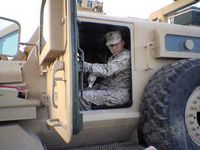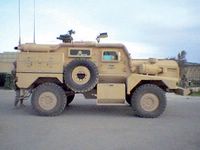 |  | High Resolution, Public Domain Images Mine Resistant Ambush Protected vehicle (The Cougar). |
Mine resistant ambush protected vehicles counter IEDs, ambushes Submitted by: Marine Forces Pacific Story Identification #: 2005624185238 Story by Pfc. J. Ethan Hoaldridge,
U.S. MARINE CORPS FORCES PACIFIC, CAMP H. M. SMITH, Hawaii (June 24, 2005) -- “Block off all their main and secondary supply lines for these are their main arteries, and ambush them along those routes for they are exposed and easy prey.”
These words from Abu Musab al-Zarqawi were cited by the Winds of Change website, showing the real danger for convoys traveling Marine supply lines in Iraq.
There have been 341 Marines killed in action and 4,099 wounded in combat during Operation Iraqi Freedom since February 16, 2004. How many of these fatalities and casualties have been caused by improvised explosive devices and ambushes on convoys? Mine Resistant Ambush Protected Vehicles could’ve saved some of those lives and kept those Marines in the fight.
With its flat bottom and soft-skin plastic doors, if a humvee is directly hit by a land mine or IED, most likely the passengers inside will lose their life and the vehicle will be destroyed beyond repair, said Maj. Gert de Wet, Central Command plans officer.
“In 1968, South Africans in conjunction with Rhodesians started developing the technology to create new vehicles that would counter the land mine threat introduced in the Bush War in Southern Africa. They developed the technology that created a new modular design for their military vehicles. For example, the vehicle’s wheels could be blown off in a mine/IED blast, but the passengers and the rest of the vehicle survived,” said de Wet.
“South Africa and Rhodesia did not have a large military and realized that you cannot afford to loose lives on the battlefield,” said de Wet. “These countries also didn’t have a large military budget and soon found that it was too expensive to loose a vehicle every time it hit a mine. It was far cheaper to replace an axel or wheel than an entire vehicle.”
“The military in South Africa and Rhodesia have been using these vehicles for the past 30 years, steadily improving the technology,” said de Wet.
The Marine Corps recognized these vehicles’ successful track record and became interested in incorporating them into the fleet.
The Corps decided to do business with Force Protection, located in South Carolina, which is the company that developed a version of a Mine Resistant Ambush protected vehicle named the Cougar.
“These vehicles are all designed from the ground up specifically built to survive IEDs and ambushes. The v-shaped hull assists deflection of a mine or IED blast away from the vehicle’s capsule keeping the passengers safe and the vehicle intact. The vehicle is also built to rollover and is equipped with multi-point, racing style harnesses, so if the vehicle rolled 360 degrees the passengers inside would avoid injury,” said de Wet.
Ballistic glass, another feature on the Cougar, allows Marines to see and engage an enemy ambush through the gun ports in the glass not exposing themselves to fire.
In a humvee, gunners are usually perched above the vehicle on a 50-caliber machine-gun open to enemy fire, while in some vehicles the passengers inside cannot see what direction enemy fire is coming from.
“When I was deployed forward, a friend of mine was in an ambush in a light-armored vehicle,” said de Wet. “They got out of the vehicle not knowing they were being attacked on the left side and luckily didn’t take casualties. In a Cougar you could just look out the glass and engage.”
Marines started reaping the benefits of the MRAP vehicles in Fall 2004 after procuring around 27 Cougars.
Because of these benefits the 1st Marine Expeditionary Force requested 1,169 MRAP vehicles. There are different variants such as, multi-mission combat vehicles, ambulance variant vehicles, troop transport vehicles and so on.
“The Corps presently uses them in Iraq for explosive ordinance disposal. When receiving calls from convoys that come upon land mines or IEDs, they could send an EOD team out in a Cougar. So even if the mine hits the Cougar, its passengers will stand a far better chance of survival due to the v-shaped hull design and other special features incorporated in the vehicle,” explained de Wet.
The Cougar is scalable as well, meaning that it can be used for humanitarian efforts as well as combat by detaching the arms and gun systems to look less lethal, but still protects the crew against threats from terrorists such as, Al Queda.
"The Cougar has been hit by IEDs and ambushes and done very well. As far as I know to date, no one has gone to the hospital as a result of an attack,” said de Wet. “I have a friend in Iraq right now who has survived four IED blasts in the same MRAP vehicle, and after some repair, the vehicle is still in use,” he continued.
The Cougar may be the rebuttal to al-Zarqawi’s statement that the supply lines are unprotected. This vehicle could cause a role reversal between the predator and its prey.
“The Marine Corps now has an opportunity and a way to alleviate the problem of so many casualties from IEDs and ambushes in Iraq,” said de Wet.
-30-
 |  |












No comments:
Post a Comment